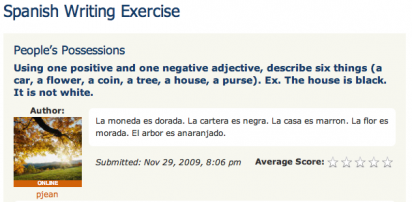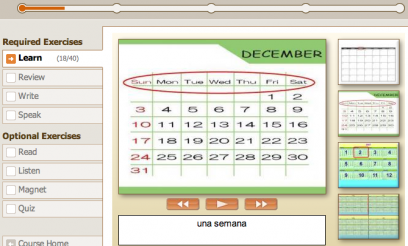Learning Ideas
Working with adults learners in a public library is a somewhat informal learning situation - there are no grades or standards. Still, it may be a good idea to facilitate the learning with some activities, prompts, and suggestions.
1. As learners work their way through the Livemocha Spanish courses, encourage them to do the Extra Practice activities under the Learn tab. These written and spoken activities, just as in the units, can be submitted (or simply done for one's own benefit). Since members can friend each other online, they can view and listen to each other's submissions (in addition to submitting them for review by native speakers), and view their progress. Below is an example of a written submission where I used positive and negative adjectives I had learned.
2. Many communities have a large number of native Spanish speakers. Encourage fellow staff members to use Livemocha to better communicate with more of their patrons. Schedule staff meetings specifically for everyone to work side by side at their computers in learning and reviewing. All of the units in Livemocha contain useful terms, but some would be especially helpful in a library setting. Unit 3-Lesson 5 contains time and time period terms, words that would be used often when communicating due dates and events to patrons. Below is a screenshot of a section from the Learn area that staff could help each other with (but also work through on their own).
3. Encourage learners to hold babelwithme group chats where they can discuss what they are learning in Livemocha. For example, Unit 1-Lesson 1 covers first nouns. Learners can make efforts to use the terms covered in this unit, such as hombre, mujer, and nina. (Even if people are working on different units, the convenient translation feature of babelwithme ensures that everyone can follow along and learn new terms). People could even have group chats with members they meet through Livemocha! Below is an example of my chat (with myself) using first nouns and adjectives.
4. Hold regular meetings in the library where learners can interact with each other in person. These could perhaps involve work in a computer lab, where learners are side by side helping one and other in Livemocha. Or this time could simply be used for them to practice what they have learned in Livemocha. People would most certainly learn a great deal from being surrounded by others speaking Spanish. This time could even be used for some written exercises. During these meetings, prompt members with questions (check out Livemocha's Extra Practice area) that would require them to use the terms they have learned in Livemocha (or even those they have learned from the additional resources). Here are some sample questions/prompts:
Additionally, you could display a bulletin board or PowerPoint showing how members are progressing through Livemocha. Seeing how others are moving through the program would likely motivate them more - though this information is accessible in Livemocha itself.
- Have half of the group hold objects (purses, wallets, money). Have the others use the adjectives (and any others) and numbers they learned in Unit 1-Lesson 3 and Unit 1-Lesson 5 of Livemocha to describe them.
- Have half of the group perform various activities (walk, run, jump). Ask the other group members to describe what they are doing with verbs they learned in Livemocha.
- Have everyone get in pairs, and write out a description of their careers or daily work. Take turns translating each other's work.
Additionally, you could display a bulletin board or PowerPoint showing how members are progressing through Livemocha. Seeing how others are moving through the program would likely motivate them more - though this information is accessible in Livemocha itself.
5. After their chats and meetings, members could use Zoho Planner to take notes on what they have learned. Along with Livemocha, this will give them a good idea of the progress they are making. Learners can either make these pages public, or e-mail them to their fellow members to share their progress. Below is an example of notes I took.
6. Lastly, use Livemocha and this entire Spanish language learning experience specifically to bring community members together - both native and beginner Spanish speakers. Hold an event where everyone can come together and communicate, and where more people can learn about Livemocha. Ask people to bring ethnic dishes, or to speak about any particular topics of interest (their country, traditions, etc.). This would be a wonderful opportunity for learners to acquire even more knowledge, and to use what they have learned in Livemocha.




